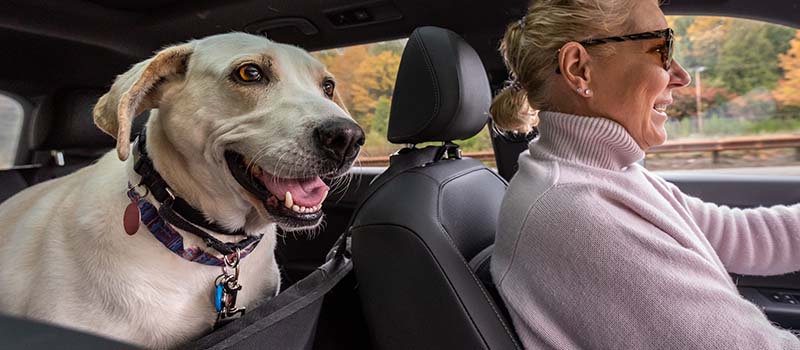Driving Safely With Pets
Driving Safely With Pets

Driving Safely With Pets
Before You Travel
If this is your pet’s first road trip, you may want to get them accustomed to traveling in a vehicle ahead of time. This is especially important if you’re planning an extended road trip and if your pet has only spent limited time riding in your vehicle. It may be a good idea to ease your pet into this type of travel by taking them on some shorter trips first. Just like people, pets can also get anxious during long car rides, and some pets even experience motion sickness. It’s better to get a feel for your pet’s comfort level in advance of a longer drive, and you may even want to consider speaking with your veterinarian to see if medication may help your pet while traveling.
Be sure that you have the proper equipment to keep your pet secured and safe while riding in your vehicle. Unrestrained pets can cause dangerous distractions to drivers. More importantly, unrestrained pets can be injured severely in the event that an accident occurs. You may opt to use a pet crate or carrier to keep your pet safe during travel, and it should be well-ventilated and large enough to allow your pet to stand, lie down and turn around comfortably. Properly secure your crate or carrier so that it does not slide or shift in the event of a sudden stop. If crates or carriers don’t work well for your pet, it is recommended that you use a pet seat belt or harness attached to the vehicle’s seat belt. Depending on your pet’s size, you’ll want to investigate what kind is best. Regardless of what type of pet you have, you should never put your pet in the front seat of your vehicle, as they could be seriously injured if an air bag deploys during an accident.
Pack Appropriately
Remember to pack extra supplies for your pets. Items you might need to pack include:
- Water (bottled water is recommended), food and bowls
- Toys or blankets
- Bed or cushion for overnight stays
- Leash, collar and ID tag
- Medications
- Waste disposal supplies, including a scoop, bags, litter and tray
- First aid supplies and grooming items
- If you’re planning to cross state lines, pack documents like a Certificate of Veterinary Inspection and/or veterinary records
During Your Trip
While you’re driving, remember that your pet needs frequent breaks too. Try to stop every two to three hours to let your pet get a drink of water, some exercise and a chance to relieve themselves. During your stops, be sure that your pet has their collar on (including ID tag), with a leash attached. If you need to stop and can’t bring your pet with you, remember that a hot car can be a dangerous place for any animal. Minimize stops where pets are left alone in the car, especially in the heat of the summer. Even in comfortable temperatures, leaving your pet in the car for an extended period of time might not be the best idea, as you never know how they might react. There’s always a chance that Rover might get frustrated and use your vehicle’s seats as a chew toy, so try to take your pet with you whenever possible.
When it comes to staying overnight, remember to choose locations that are pet-friendly. Many hotels offer pet-friendly options for an additional fee, but it doesn’t hurt to double check before you arrive. If you’re planning to stay at an Airbnb or Vrbo rental, you can also search with filters that allow you to select housing options that accept pets.
Get the Protection You Need to Feel Secure on the Road
No matter where you’re headed or what four-legged friends you might be bringing along for the ride, make sure you have the protection you need to feel safe while traveling. If you’re unsure about your current auto insurance coverage or whether you might need additional coverage in the event of an accident, reach out to your local agent. They will be happy to answer any questions you might have, no matter what your travel plans may be.
